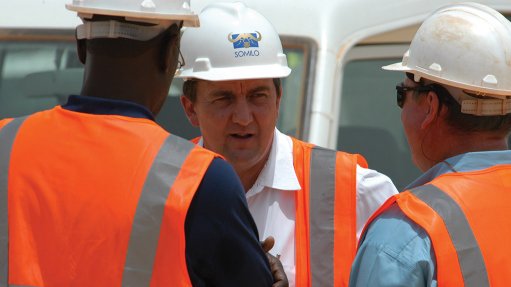
Barrick president and CEO Mark Bristow
NYSE- and TSX-listed Barrick Gold Corporation and its Senegalese joint venture partner Compagnie Sénégalaise de Transports Transatlantiques Afrique de l’Ouest will sell their 90% interest in the Massawa project, in Senegal, to TSX-listed West African gold miner Teranga Gold Corporation for up to $430-million.
The purchase price will include an upfront payment of $380-million, comprising $300-million in cash and about 20.72-million Teranga shares, as well as a contingent payment of up to $50-million based on the average gold price for the three-year period immediately following the closing of the transaction.
The contingent payment will be $25-million if the three-year average gold price is between $1 450/oz and $1 500/oz; $35-million if the three-year average gold price is between $1 500/oz and $1 600/oz; and $50-million if the three-year average gold price exceeds $1 600/oz.
Barrick president and CE Mark Bristow said the group had been pursuing the best means of bringing Massawa, discovered by its legacy company Randgold Resources ten years ago, to account for the full benefit of all stakeholders. The agreement with Teranga, which will realise the full value of this asset and create a substantial new West African gold mining company with significant African ownership, is the outcome of that process.
“It is gratifying to continue the value-creating consolidation of assets in the gold mining sector which started a year ago with the merger between Barrick and Randgold, followed shortly thereafter by the merger of the Nevada assets of Barrick and Newmont Goldcorp.
"In the case of Massawa, Teranga has the appropriate infrastructure and processing facilities about 25 km away, and combining the ore bodies and the geological prospectivity will add further benefits. This is a good example of an instance where assets we own might be better suited in combination with others,” Bristow said.
Teranga president and CEO Richard Young commented that the acquisition was transformational for the company and would enable it to create a top-tier gold complex in Senegal.
He pointed out that Massawa was one of the highest-grade undeveloped openpit gold reserves in Africa and that it was located within trucking distance of its own flagship Sabodala gold mine, which created the opportunity for significant capital and operating synergies.
“We anticipate that production from the Sabodala-Massawa Complex, together with our Wahgnion gold mine, in Burkina Faso, will increase Teranga’s targeted consolidated annual gold production and reposition Teranga as the next multi-asset, low-cost, midtier gold producer in West Africa, one of the world’s premier gold mining regions,” he added.
The transaction is expected to close in the first quarter of 2020.
Barrick will become Teranga's second-largest shareholder, holding about 11.45% of Teranga's shares.
SABODALA-MASSAWA COMPLEX
Massawa’s permits and the Sabodala mine licence are contiguous with each other. Massawa hosts historical mineral reserves of 2.6-million ounces and Sabodala’s mineral reserves are 2.4-million ounces.
Sabodala currently mines between 35-million and 40-million tonnes of material and processes over four-million tonnes of ore a year.
Teranga plans to integrate the high-grade ore from the Massawa deposits into an optimised combined mine plan for Sabodala, leveraging its existing infrastructure, plant, mobile equipment and personnel.
It believes minimal changes will be required to Sabodala’s existing carbon-in-leach (CIL) plant and infrastructure to process free-milling ore from Massawa. This will reduce the initial phases of capital costs included in an earlier Massawa feasibility study.
Teranga plans to start processing free-milling ore from the Massawa deposits at its existing CIL plant in the second half of 2020 and to mine and process Massawa’s high-grade reserves on a priority basis.
"It is anticipated that, by 2021, more than half of the ore processed through the Sabodala plant could potentially be sourced from the Massawa deposits," Teranga stated.
Teranga and Barrick said they had invested significant resources in due diligence to gain a better understanding of the technical details of the Massawa ore bodies to help Teranga develop an optimised, integrated mine plan for the two properties. This includes detailed resource modelling for the mineralogical characterisation, the chronology of metallurgical testwork to determine BIOX as the process of choice for the refractory ore in a retrofitted Sabodala plant and a revised life-of-mine plan that optimises the timing of the Sabodala and Massawa ore bodies for processing, as well as yearly operating and capital costs.
The detailed due diligence work will form the basis for initiating a prefeasibility study that Teranga will complete for the integrated Sabodala-Massawa Complex within six months of the transaction closing.
In advance of an integrated definitive feasibility study, Teranga will embark on a drill programme to expand the resource base of the Massawa project. The definitive feasibility study, which is expected to be completed in 2021, will assess the optimal size of the retrofit and the timing of implementation for processing of the refractory components of the Massawa ore.